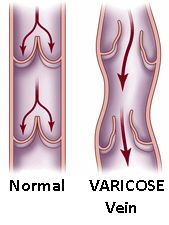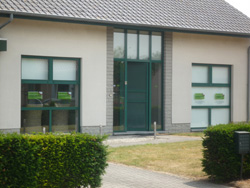Varicose veins
Varicose veins are a very common condition in Europe and affect approximately 20% of men and approximately 40 % of women.
Varicose veins are caused by damaged valves and weakened vein walls due to local “high” pressure. Normally, the one-directional valves in veins keep the blood flowing efficiently against gravity up toward the heart. But when these valves fail to function properly, the blood falls back and pools, pressure builds up and the veins become weak, enlarge and get twisted. Some people may be more likely than others to develop varicose or spider veins due to genetics, age or hormonal changes. Varicose veins may also result from conditions that increase pressure on the leg veins as overweight, pregnancy, or doing jobs that require prolonged standing. That is the reason why varicose veins mainly occur in the legs or lower extremities.
Is this only a cosmetic concern? No! For many men and women, varicose veins and spider veins (these are the smaller and more common variation of varicose veins) are esthetical damaging. However, it's important to note that for others, varicose veins cause symptoms. This condition may lead to serious problems if not treated. Moreover, varicose veins may also serve as an indication that you are at a higher risk for other disorders of the circulatory system.
Risk Factors:
Genetics. Varicose veins are mostly hereditary. They develop through a genetic weakness of the vein wall. Because we started a live standing up right, varicose veins grow due to the gravitational forces and this especially in your legs.
Pregnancy. Both the hormonal influences on the vein wall as the limited backflow of venous blood through the veins to the hart, due to the increasing obstructive pressure of the growing Uterus, influence the growth of varicose veins.
Standing for long periods of time. Blood doesn't flow as well if you're in the same position for long periods of time because your muscles are not contracting to push the blood back to the heart.
Obesity. Extra weight puts more pressure on your veins.
Age. The normal processing of aging causes wear and tear on the valves in your veins which regulate blood flow. The wear and tear causes the valves to slowly malfunction.
Gender. Women have a higher chance than men are to develop varicose veins and spider veins. This is attributed to hormonal changes during pregnancy, and also premenstruation or menopause may be a factor. Some researchers have found that female hormones may relax vein walls. Moreover, the use of hormone replacement therapy or birth control pills may increase the risk of varicose veins.
Symptoms:
In the beginning the majority of patient will not have any complaints. Esthetical damage will be the only concern. For those that do experience a discomfort, the following are some of the symptoms:
- A continuous dull pain or heavy feeling in one's legs, burning, throbbing, muscle cramping and swelling in the lower legs and swollen ankles.
- Restless legs and the feeling that sometimes something is wandering across ones leg may also become a symptom.
- Itching in your legs in and around your swollen veins.
- In more severe cases, varicose veins might evolve towards a painful inflammation of the sick vein( phlebitis), an inflammation with obstruction of the vein with blood clots( trombophlebitis).
- Painful skin ulcers near your ankle, which represent a severe form of this vascular disease.
If you have varicose veins, typically prolonged sitting or standing tends to make your legs feel worse. The varicose veins are easy to spot because they are dark purple or blue in color and sometimes appear twisted and bulging. The most common spot they appear is on the inside of the leg or on the back of your calves. But, they can form anywhere on your legs, from your groin to your ankle.

Diagnosis:
Prior to making a diagnosis, we will examine your legs while you're standing up and look for local bulging and swelling. Next a thorough Duplex ultrasound examination will be performed to determine the extent of your varicose vein disease. This is a painless and outpatient technique called a varicose vein mapping and is essential to determine which kind of treatment or combination of treatments will best fit your needs. The full detailed clinical examination will take up to one hour. This makes that the choice of treatment for varicose veins will always be a personalized one. Dr. Harry Spoelstra, who has more than 25 years of experience in this field, in the diagnose and treatment of varicose veins, can be professionally proud to state: “Your legs, your pride, our profession”.
